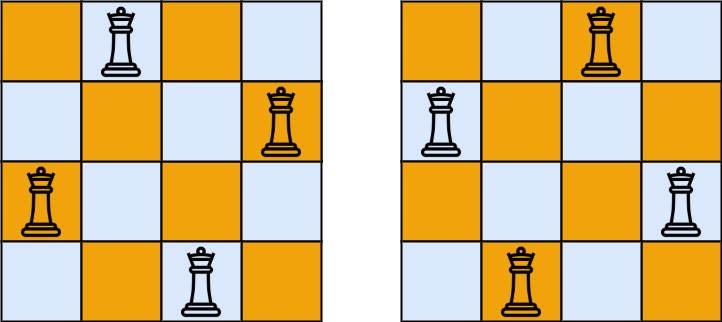Description
The n-queens puzzle is the problem of placing n queens on an n x n chessboard such that no two queens attack each other.
Given an integer n, return all distinct solutions to the n-queens puzzle. You may return the answer in any order.
Each solution contains a distinct board configuration of the n-queens’ placement, where 'Q' and '.' both indicate a queen and an empty space, respectively.
Example 1:

Input: n = 4 Output: [[“.Q..”,“…Q”,“Q…”,“..Q.”],[“..Q.”,“Q…”,“…Q”,“.Q..“]] Explanation: There exist two distinct solutions to the 4-queens puzzle as shown above
Example 2:
Input: n = 1 Output: “Q”
Constraints:
1 <= n <= 9
Code
先放第一個 row,再放第二個 row,直到第 n 個 row,發現不行就退回上一個 row,換一個 col 重新試試看。
class Solution {
public:
vector<vector<string>> solveNQueens(int n) {
vector<vector<string>> answer;
vector<string> curr(n, string(n, '.'));
solve(0, n, answer, curr);
return answer;
}
void solve(int row, int n, vector<vector<string>>& answer, vector<string>& curr) {
if(row == n) {
answer.push_back(curr);
return;
}
for(int col = 0; col < n; col++) {
if(check(row, col, n, curr)) {
curr[row][col] = 'Q';
solve(row+1, n, answer, curr);
curr[row][col] = '.';
}
}
}
bool check(int row, int col, int n, vector<string> curr) {
for(int i = 0; i < row; i++) {
if(curr[i][col] == 'Q') return false;
}
for(int i = row - 1, j = col - 1; i >= 0 && j >= 0; --i, --j) {
if(curr[i][j] == 'Q') return false;
}
for(int i = row - 1, j = col + 1; i >= 0 && j < n; --i, ++j) {
if(curr[i][j] == 'Q') return false;
}
return true;
}
};